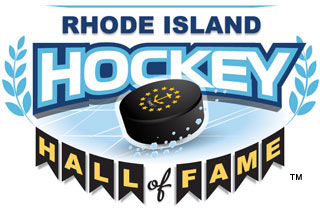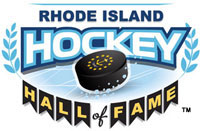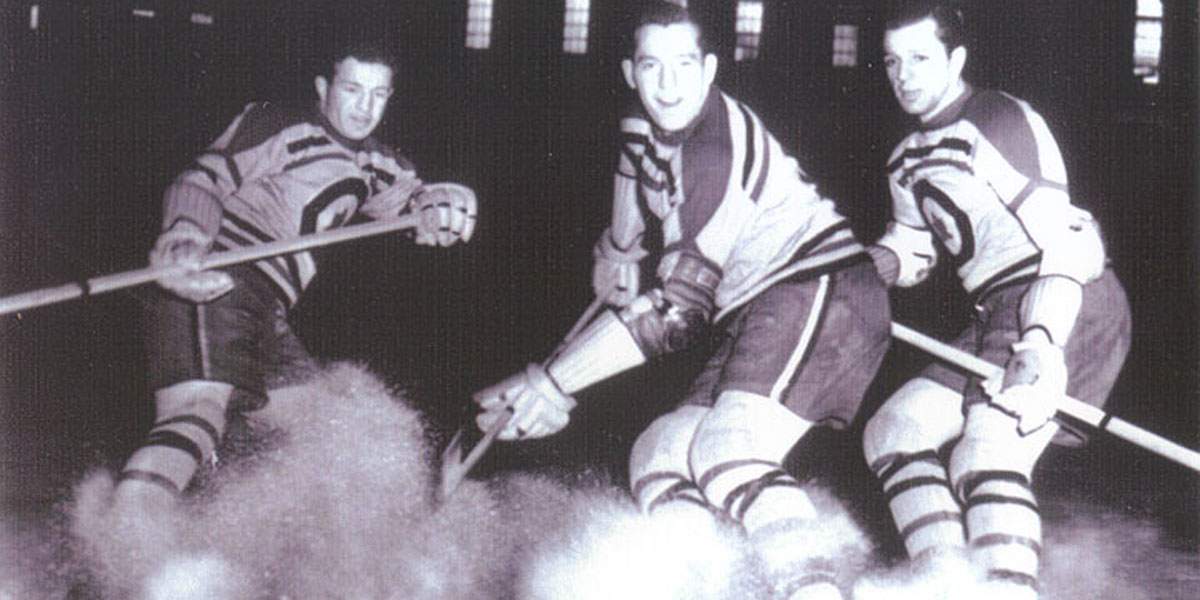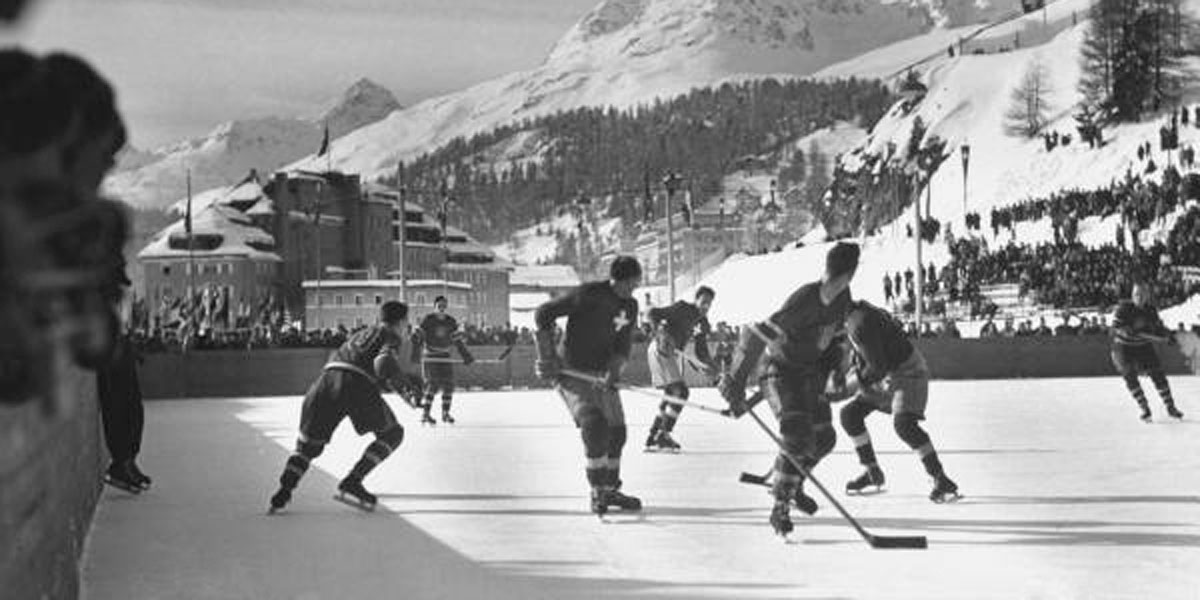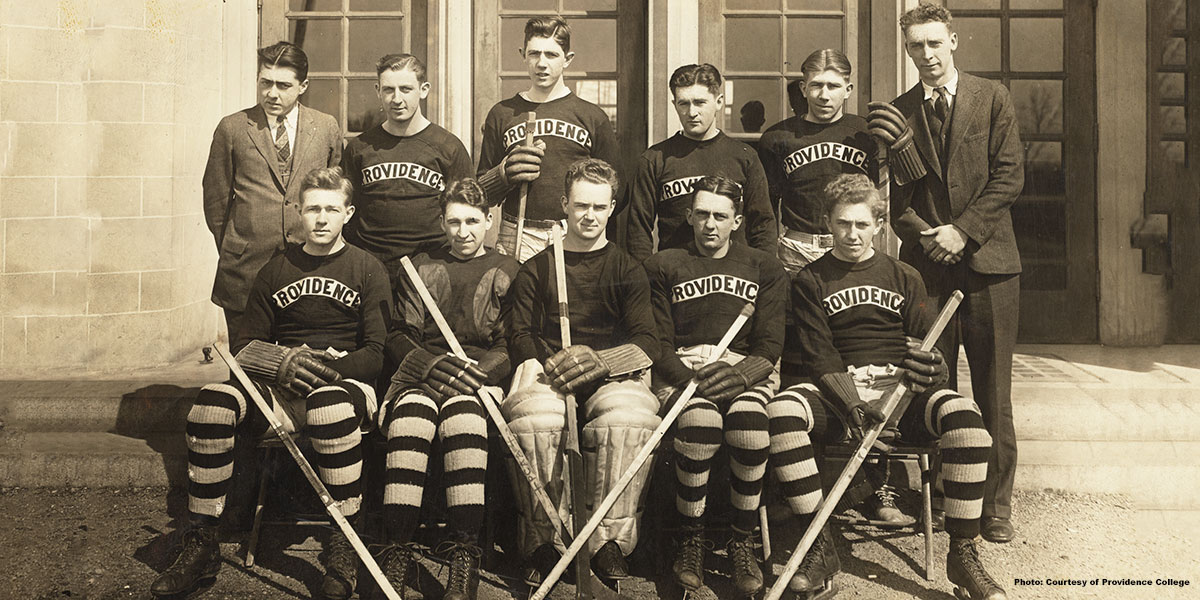RI Hockey History Timeline
Our sincerest gratitude to Mark Divver for this colorful timeline of our state’s rich hockey history
There aren’t many places in the United States that can match Rhode Island’s extraordinary hockey heritage.
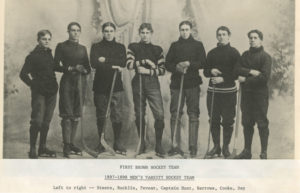 The game has been played here for at least 125 years.
The game has been played here for at least 125 years.
There’s no way to pinpoint exactly when in the late 1800s Rhode Islanders first started clamping blades to the bottom of their shoes or lacing up skates and taking to frozen ponds and lakes with sticks in their hands.
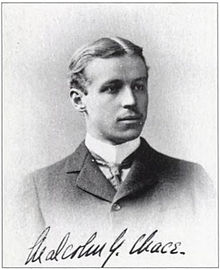 But it is a matter of record that our state’s rich hockey history and the first days of the game in New England and, indeed, in the United States are intertwined.
But it is a matter of record that our state’s rich hockey history and the first days of the game in New England and, indeed, in the United States are intertwined.
The first official game of the USA’s first Intercollegiate Hockey League was won by Brown University over Harvard, 6-0, on January 18, 1898.
Thanks to longtime Providence Journal columnist John Hanlon’s wonderful Sports Illustrated story from 1967, we know that a Rhode Islander – Malcolm G. Chace – was front and center in hockey’s earliest days here.
And, based on the facts laid out by Hanlon, you might rightly call Chace the “father” of hockey in the United States.
EARLY DAYS
It took no time at all for the seeds planted by Chace and company to take root.
One year after the Brown-Harvard game, the RI Interscholastic League was born. The schoolboy hockey league was the brainchild of a Brown hockey player and team manager who envisioned a local high school hockey league as a feeder program for the Brown hockey team. The 7-team league created by the Brown Hockey Association was immediately recognized and adopted by the RIIL, which has been the overseer of RI high school hockey since December of 1902. Its first quarter century is rich in history, as chronicled in Jeff Hebert’s excellent website, rihockeylegacy.com.
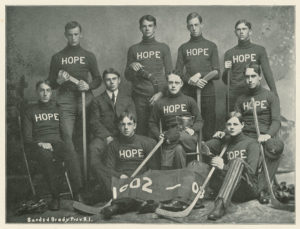 Providence’s Hope Street High School took home the first schoolboy championship. Games were played outdoors, of course, and were at the mercy of the weather. In 1906, 1909 and 1915, there was no champion because warm weather did not allow enough games to be played. Blackstone Pond, Mashapaug Pond, Roger Williams Park and the wonderfully named No Bottom Pond in Providence were among the places where games were played.
Providence’s Hope Street High School took home the first schoolboy championship. Games were played outdoors, of course, and were at the mercy of the weather. In 1906, 1909 and 1915, there was no champion because warm weather did not allow enough games to be played. Blackstone Pond, Mashapaug Pond, Roger Williams Park and the wonderfully named No Bottom Pond in Providence were among the places where games were played.
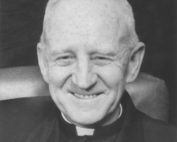 In 1911, Brother Adelard Beaudet came to Woonsocket from his native Quebec.
In 1911, Brother Adelard Beaudet came to Woonsocket from his native Quebec.
As Sports Illustrated put it in a 1985 article, he arrived “with a cross on his chest and a hockey stick over his shoulder. He is a missionary of dual purpose, coming to teach the children the way of the Lord and of the slap shot.’’
Brother Adelard soon got a hockey team going at Mount St. Charles Academy, and the rest is history.
THE 20’s
Until the 1925-26 season, high school hockey was played with seven players: left wing, center, rover, right wing, cover point, point and goal.
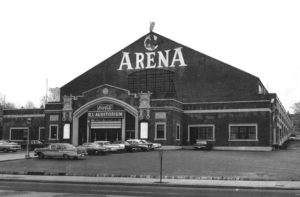 A pivotal moment in the history of Rhode Island hockey dawned with the opening of the Rhode Island Auditorium (aka The Arena), at 1111 North Main Street, Providence, on Feb. 18, 1926. The first indoor ice surface in the state, the 5,500-seat building became the epicenter for the sport at all levels for more than five decades.
A pivotal moment in the history of Rhode Island hockey dawned with the opening of the Rhode Island Auditorium (aka The Arena), at 1111 North Main Street, Providence, on Feb. 18, 1926. The first indoor ice surface in the state, the 5,500-seat building became the epicenter for the sport at all levels for more than five decades.
The opening of the Auditorium was quickly followed by the birth of Providence’s first professional team, the Providence Reds of the Canadian-American Hockey League, forerunner of our American Hockey League (AHL).
Judge James E. Dooley owned the team and former Major League pitcher Jean Dubuc, who was implicated in the infamous Black Sox scandal, was the first general manager.
The Reds played their inaugural game on Dec. 3, 1926. They lost, 7-1, to the Springfield Indians with Montreal Canadiens’ farmhand, Hec Lepine, scoring the Reds very first and only goal. But the crowd at the Auditorium didn’t go home disappointed as Brick Morrison of the home team won a pair of fights.
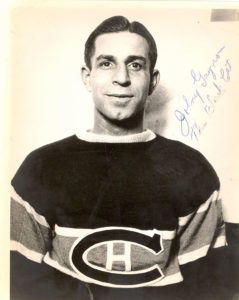 A little more than a decade later, Louis A. R. Pieri would purchase both the building and the team and take the Reds and the game to greater heights. The Reds would thrive for the better part of 51 winters. Thanks to them, generations of Rhode Islanders fell in love with the game as both fans and players.
A little more than a decade later, Louis A. R. Pieri would purchase both the building and the team and take the Reds and the game to greater heights. The Reds would thrive for the better part of 51 winters. Thanks to them, generations of Rhode Islanders fell in love with the game as both fans and players.
Johnny “The Black Cat’’ Gagnon established himself as Providence’s first professional hockey star with the Reds. He scored 20 goals in 39 games in 1927-28 and 21 in 39 games in 1929-30 before going on to play 10 years with the Montreal Canadiens.
The Reds won their first championship in 1929-30, taking home the Fontaine Cup after defeating the Boston Tigers, three games to none.
Industrial league hockey caught on in the 1920s, with companies such as Brown & Sharpe and the Providence Gas Co. fielding teams that played at the Auditorium.
THE 30’s
Though high school hockey had been played for years, the 1930s saw players born and bred in Rhode Island begin to emerge as college stars and go on to represent the USA in World Championships and the Olympics.
In 1934, LaSalle goaltender Clem Harnedy became our state’s first representative on a USA National Team when he recorded 3 shutouts and allowed only 2 goals in 4 games at the 1934 World Championships in Milan, Italy. Thirty-three more Rhode Islanders would follow Harnedy in World Championship play.
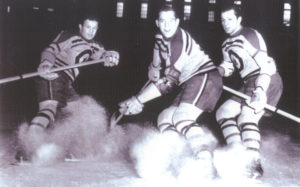 Near the end of the ‘30s, a trio that would go on to be one of the greatest lines in NHL history gained notice in Providence. It didn’t take long before Milt Schmidt, Bobby Bauer and Woody Dumart were promoted from the Reds to the Boston Bruins. Known as the “Kraut Line,’’ the trio is enshrined in the Hockey Hall of Fame in Toronto.
Near the end of the ‘30s, a trio that would go on to be one of the greatest lines in NHL history gained notice in Providence. It didn’t take long before Milt Schmidt, Bobby Bauer and Woody Dumart were promoted from the Reds to the Boston Bruins. Known as the “Kraut Line,’’ the trio is enshrined in the Hockey Hall of Fame in Toronto.
After capturing two more Fontaine Cups in the Can-Am League, the AHL was formed and the Reds won their first of four Calder Cup championships in 1937-38 with future Hall of Famer Frank “Mr. Zero’’ Brimsek in the net.
THE 40’s
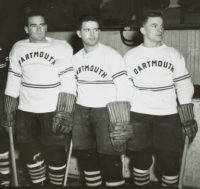 LaSalle star and Cranston native Ralph Warburton scored five goals and two assists for Dartmouth against Cornell on Jan. 20, 1945. Warburton and fellow Rhode Islanders George Pulliam and Dick Rondeau, who set 8 collegiate scoring records, starred on a Big Green team that went 45-0-1 between 1941 and 1945.
LaSalle star and Cranston native Ralph Warburton scored five goals and two assists for Dartmouth against Cornell on Jan. 20, 1945. Warburton and fellow Rhode Islanders George Pulliam and Dick Rondeau, who set 8 collegiate scoring records, starred on a Big Green team that went 45-0-1 between 1941 and 1945.
Thirteen Rhode Islanders have made Olympic rosters. Warburton became the first, scoring a remarkable 17 goals and 9 assists in just 8 games in the 1948 St. Moritz Games.
High school hockey continued to thrive in the 1940s, often drawing SRO crowds at the Auditorium. Mount St. Charles won five state championships during the decade and Burrillville captured three.
After suffering through some lean years during World War II, the Reds captured the Calder Cup in 1948-49 under coach Terry Reardon, who would go on to be an influential figure in team history for many years. Carl Liscombe won the AHL scoring championship with 50-68-118 and was league MVP for the second season in a row.
THE 50’s
In 1951, Brown advanced to the NCAA championship game for the first and only time in school history. The Bears lost, 7-1, to Michigan in Colorado Springs. Also that year, little Burrillville High School in rural northern Rhode Island, captured its first New England high school hockey crown. They would go on to win four more, tied for the most ever in the legendary tournament.
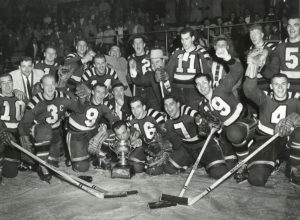 In many ways, the 1950s were the golden age of the Reds. Sunday night games became a social happening as a broad cross-section of Rhode Islanders – factory workers and wealthy East Siders, politicians and mobsters – rubbed shoulders at the Auditorium.
In many ways, the 1950s were the golden age of the Reds. Sunday night games became a social happening as a broad cross-section of Rhode Islanders – factory workers and wealthy East Siders, politicians and mobsters – rubbed shoulders at the Auditorium.
On the ice, the talent in the AHL was never better than during the ‘50s, the glory days of the NHL’s Original Six.
Providence won the Calder Cup in 1955-56 with a powerhouse team that featured stars such as Zellio Toppazzini and Johnny Bower. The Society for International Hockey Research voted that Reds’ season the greatest-ever minor league hockey season. It would be the final Calder Cup in Reds’ history.
THE 60’s
After retiring as players, former Reds greats like Toppazzini, Art Lesieur, Harvey Bennett, Sr., Norm Calladine and Chuck Scherza made their homes in Rhode Island. They served in numerous capacities from refereeing to coaching a new generation of local talent.
The influence of ex-pros on Rhode Island’s hockey culture in these years can’t be overstated. Bennett’s Sunday morning hockey school at the Auditorium was instrumental in developing a legion of players who would go on to be top performers in the high school and college ranks, not to mention a handful who would reach the NHL.
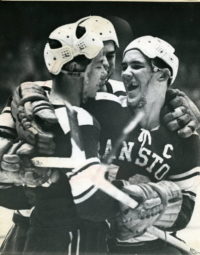 Led by stars such as Joe Cavanagh and Curt Bennett, one of Harvey’s many hockey-playing sons, Cranston East fielded perhaps the greatest high school team in Rhode Island history in the mid to late ‘60s.
Led by stars such as Joe Cavanagh and Curt Bennett, one of Harvey’s many hockey-playing sons, Cranston East fielded perhaps the greatest high school team in Rhode Island history in the mid to late ‘60s.
Both Brown and PC raised their national profiles during those years.
Brown opened its own rink, Meehan Auditorium, on Hope Street, in 1961. The rink was designed and engineered by LaSalle & University of Illinois grad, Henry Coupe. Hank, a former professional player-coach, himself, would become one of the foremost ice rink consultants in the world.
The Friars had their first moment in the sun in 1964. Stacked with local stars and two All-Americans, Burrillville’s Tom Eccleston piloted them to the NCAA Final Four for the first time in school history.
That same year, Brown’s Pembroke Pandas were formed, becoming the first women’s college hockey program in the United States.
In 1965, with US Hockey Hall of Fame coach Jim Fullerton at the helm, Brown hosted the Final Four and also played in it. Michigan Tech went home with the title.
The Reds endured some brutal years in the mid-‘60s. One lowlight was a stretch of 64 games (0-57-7) without a win on the road that lasted from Feb. 9, 1966, to Dec. 30, 1967. That’s an AHL record for futility that still stands.
THE 70’s
You could say this decade was the best of times and the worst of times for hockey in Rhode Island.
In 1971, Cranston’s Joe Cavanagh graduated Harvard with the Beanpot Tournament scoring record. Cavanagh, a three-time All-American with the Crimson, scored 7 goals and 19 points in just 6 games. It’s a record that will probably never be broken.
The Providence Civic Center opened downtown in October 1972, giving the Reds a brand-new arena to replace the crumbling Auditorium.
In September 1973, the doors opened at PC’s new Schneider Arena, providing the Friars with a place to play on campus for the first time. East Providence’s Ron Wilson, who would go on to be the greatest player in school history, made his Friar debut in the 1973-74 season.
In 1975, Mount St. Charles hired Bill Belisle – a member of its 1947 state championship team – as its coach. At the time, no one could have imagined the heights that the Mounties would reach under Belisle.
For the first time, a former Rhode Island high school player made it as an NHL regular. After an All-American career at Brown, Curt Bennett posted back-to-back seasons of over 30 goals for the Atlanta Flames – the first American-developed player to do so – and played in two straight NHL All-Star Games in the mid-70’s.
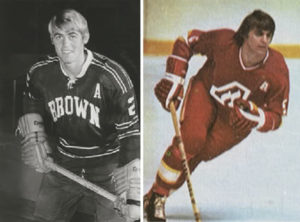 Two of Curt’s younger brothers, Harvey Jr. and Bill, made it to the NHL in the second half of the decade, giving the family an incredible hat trick of players in the world’s top league.
Two of Curt’s younger brothers, Harvey Jr. and Bill, made it to the NHL in the second half of the decade, giving the family an incredible hat trick of players in the world’s top league.
Brown had the best season in school history in 1976-77, reaching the NCAA Final Four again. The Bears haven’t been back since.
It was a sad day, indeed, when the Providence Reds left town for Binghamton, N.Y., in the summer of 1977, a victim of seismic changes in the landscape of both minor and major league hockey. The AHL would not return to Providence for 15 years.
THE 80’s
During this decade, Rhode Island made a name for itself as a breeding ground for NHL draft picks.
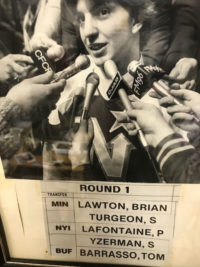 Brian Lawton of Cumberland and Mount St. Charles made history when the Minnesota North Stars picked him first overall in the NHL Draft in 1983. It was a watershed moment, the first time an American had been the No. 1 pick. The 18-year-old Lawton had planned to attend PC, but ended up signing an NHL contract and went straight from the Interscholastic League to the NHL.
Brian Lawton of Cumberland and Mount St. Charles made history when the Minnesota North Stars picked him first overall in the NHL Draft in 1983. It was a watershed moment, the first time an American had been the No. 1 pick. The 18-year-old Lawton had planned to attend PC, but ended up signing an NHL contract and went straight from the Interscholastic League to the NHL.
A year later, David Quinn of Cranston was selected in the first round, 13th overall, by Minnesota.
Bishop Hendricken featured a forward line of Steven King, Rob Gaudreau and David Emma, all of whom would go on to star in college and play in the NHL.
Other Rhode Islanders would be drafted throughout the 80’s – including players such as Jack and David Capuano, Keith Carney and Clark Donatelli.
PC’s Lou Lamoriello was the main architect in the formation of Hockey East in 1984, as some of the top hockey-playing schools in New England broke with decades of tradition to form what would become an iconic league in the college game.
In the first-ever Hockey East championship game in 1985, 5-foot-8 Chris Terreri of Warwick’s Pilgrim High put on an unforgettable 65-save display of goaltending in PC’s epic double overtime win over Boston College at the Providence Civic Center.
A couple of weeks later, the Friars lost, 2-1, in the national championship game to an RPI squad led by future Hall of Famer Adam Oates. Terreri, who would go on to a long NHL career and play on two Stanley Cup-winning teams, was named tournament MVP.
The greatest high school series in state history was played in 1988 between Mount St. Charles and Hendricken. With the best-of-three series tied at a game each, Hendricken was 14 seconds away from a championship when Mount’s Jeff Robison tied the game. After multiple overtimes, Game Three was declared “no contest.’’ The same thing happened in Game Four. Mount finally took home the title again with a 5-1 victory in the fifth game.
THE 1990’s
David Emma of Cranston, Hendricken and Boston College won the Hobey Baker Award in 1991. He remains the only Rhode Islander to be honored as college hockey’s top player, although many have been name finalists for the coveted award.
The AHL finally returned to Providence in 1992. In their first home game, the Providence Bruins routed the Hershey Bears, 9-2, before a capacity crowd of 11,909 at the Civic Center on Oct. 16, 1992. Peter Laviolette was the team’s first captain.
Two teenagers from Woonsocket made history when they were both selected in the first round of the 1995 NHL Draft. Bryan Berard became the second Rhode Islander to be the No. 1 overall pick when he was taken by the Ottawa Senators. Brian Boucher, Berard’s teammate in youth hockey with the Woonsocket North Stars and at Mount St. Charles, was taken 22nd by the Philadelphia Flyers.
 Seven Providence College players and two from Brown were members of the U.S. team that won the first Olympic gold medal in women’s hockey in 1998. From PC were USA flagbearer and team captain Cammi Granato, Warwick’s Sara DeCosta-Hayes, Vicki Movsession, Lisa Brown-Miller, Laurie Baker, Chris Bailey and Alana Blahoski. From Brown were Tara Mounsey and Katie King.
Seven Providence College players and two from Brown were members of the U.S. team that won the first Olympic gold medal in women’s hockey in 1998. From PC were USA flagbearer and team captain Cammi Granato, Warwick’s Sara DeCosta-Hayes, Vicki Movsession, Lisa Brown-Miller, Laurie Baker, Chris Bailey and Alana Blahoski. From Brown were Tara Mounsey and Katie King.
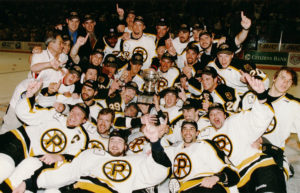 In 1999, Jeff Jillson of North Smithfield and Mount St. Charles became the fifth Rhode Islander to be selected in the first round of the NHL Draft when the San Jose Sharks picked him 14th.
In 1999, Jeff Jillson of North Smithfield and Mount St. Charles became the fifth Rhode Islander to be selected in the first round of the NHL Draft when the San Jose Sharks picked him 14th.
With Peter Laviolette behind the bench, the P-Bruins capped their greatest season by winning the 1998-99 Calder Cup. Before a roaring sellout crowd at the Civic Center on Sunday afternoon, June 14, the P-Bruins beat the Rochester Americans, 5-1, to take the series in five games. East Greenwich’s Steve King scored four goals in the finals, including two game-winners.
THE 2000’s
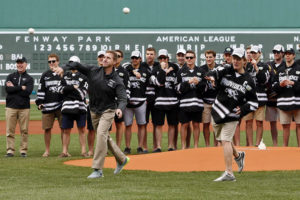 The NCAA Frozen Four was played in Providence for the seventh and final time in 2000 when North Dakota defeated Boston College in the title game. With a capacity of just under 12,000, the building is now too small for the finals, though regionals are played here on a regular basis.
The NCAA Frozen Four was played in Providence for the seventh and final time in 2000 when North Dakota defeated Boston College in the title game. With a capacity of just under 12,000, the building is now too small for the finals, though regionals are played here on a regular basis.
An era ended in March 2004 when Toll Gate defeated Mount St. Charles in the high school finals, snapping Mount’s remarkable streak and national record of 26 straight state championships.
Brown goalie Yann Danis was a finalist for the 2004 Hobey Baker Award, the 11th finalist produced by our state.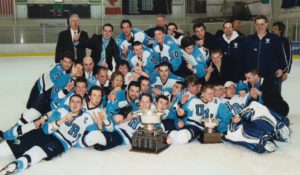
In 2006, the University of Rhode Island captured the ACHA National Championship under the leadership of longtime coach, Joe Augustine. A decade later, Augustine would eclipse the 600 wins and 1000 games coached plateaus.
In 2015, Providence College won its first NCAA hockey championship with a 4-3 win over Boston University at the TD Garden in Boston. One of the perks was throwing out the first pitch at Fenway Park. Coach Nate Leaman, who took over in 2011, built the Friars into a national power.
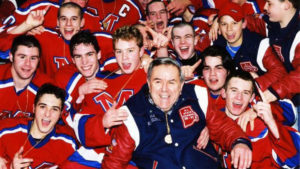 On Feb. 3, 2017, Mount St. Charles beat Smithfield, 9-2, for Bill Belisle’s 1000th win as coach.
On Feb. 3, 2017, Mount St. Charles beat Smithfield, 9-2, for Bill Belisle’s 1000th win as coach.
After spending eight seasons with the Providence Bruins – five as the assistant coach and three as the head man – Bruce Cassidy moved up to the Boston Bruins as an assistant coach for the 2016-17 season. He took over as head coach when Claude Julien was fired in February 2017.
